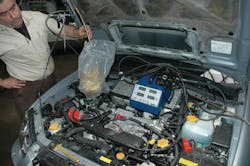Engine overheating? How to keep your cool
This article was originally published April 5, 2013. Some of the information may no longer be relevant, so please use it at your discretion.
There are quite a few vehicles out there that have common cooling system problems. BMW three series always have fan clutches and thermostats going bad. Volkswagens have bad water pumps. Late model Jeep I6s have head gasket issues. The list goes on and on.
Now, a 2006 Chevy Equinox with a 3.4L comes in with the issue of overheating and the "antifreeze boils." The boiling of antifreeze indicates that something critical is defective (clogged radiator, defective thermostat, broken water pump impeller, etc.) Since 3.4Ls don't typically have this issue, what would be the wise way to begin diagnosing this car?
1. Check the antifreeze level
This step is absolutely critical because if the antifreeze is full, we will probably test the thermostat first, and if it is low, we will pressure test the vehicle for leaks. If you are interested in what to do if this problem occurred without there being a leak, see the third step.
Since the antifreeze is boiling over, even if there isn't a leak problem, the vehicle probably is low on antifreeze, so to check for a leak, we top the vehicle off with antifreeze and attach the pressure tester where the radiator cap is. Some vehicles don't have radiator caps, but they have pressurized overflow containers where the pressure tester connects to.
Regardless of where you connect to, you should be able to tighten the tester's adapter, so it makes a leak-proof seal and pressurizes the system to 15 psi. That system should hold at least 15 psi of five minutes. If not, look for leaks. Any component that is visibly leaking should be replaced, but what if you don't see any leaks, and you are losing pressure?
2. Test for a bad head gasket
The old fashioned way to test for a bad head gasket is to pressure test the vehicle, and if you find a leak but don't see any, check the exhaust. If it smells and looks like burned antifreeze, you have a head gasket leak on your hands.
However, for reasons we covered in our December 2012 Tool Q&A, catalytic converters work too efficiently these days and only with extremely bad head gasket leaks will you catch it that way. Otherwise, the only way to be sure if we are not getting any antifreeze in the oil is to use an emissions analyzer.
Simply turn on your emissions analyzer and check the HC levels in the shop. The number should be close to zero. Then, open the radiator cap and make a tent around it with some shop rags. If you are afraid of a coolant bubble shooting out and getting into your probe, use a no-spill antifreeze funnel and half a windshield washer bottle. In the hole on the top, put your probe. When you do this, see if HC levels soar.
If they do, you have confirmed the head gasket is bad because HC from the combustion chamber of the engine is now getting into the antifreeze. This, in turn, confirms antifreeze is going into the combustion chamber and out the tail pipe. In extreme situations, this can make a boiling effect as the exhaust escapes.
3. Test for items that cause overheating without the system being low on antifreeze
What if we have this problem, and the antifreeze level is not low? The first component we test is the thermostat.
To test a thermostat, first make sure that the system is ambient temperature, and the thermostat is closed. As the vehicle warms up, feel the thermostat hose. At the same time, use a scan tool and graph the Engine Coolant Temperature (ECT) PID. When ECT reaches the range where the thermostat is rated to open, feel the thermostat hose. The hose should turn from cool to hot.
If the ECT PID goes up very slowly, for example, an increase of only 10 degrees F every few minutes, then you likely have a "sticky" thermostat. The EScan from Automotive Test Solutions is a scan tool with a thermostat testing function which automatically calculates this for you, so you don't have to touch any hoses or perform any "guesstimations."
If the thermostat is good, and we notice that even when the vehicle is hot, the radiator fan didn't turn on, we might want to test the radiator fan. We can do this by using a bidirectional control on our scan tool, or lacking that, jump the radiator fan on with a Power Probe.
Using your scan tool to do the test is easy. Simply go into the engine control module and choose bidirectional controls. "Radiator fan" should be an available choice. If the fan does not engage, your scan tool might list bidirectional control but not actually do it, or more likely, the PCM driver, fan, or its wiring is defective.
The quick way to test this out is to simply whip out a Power Probe. You will need to take into account the wiring of the vehicle (i.e., is the fan grounded/powered seperately from the PCM?). Depending upon how the fan is wired, you can check to see if the fan is receiving 12V and even jump the circuit. In this way, you can prove if the fan alone is bad or if the PCM or wiring is at fault.
Most fans are grounded by the PCM, so with the Power Probe, you can bypass that ground and make your own. If the fan spins, you have a problem on the ground side. Sometimes, the fans blow fuses when they have high internal resistance. You can check amperage on the fan with an amp clamp or a Power Probe Hook when performing this test. If fan amperage is too "close" to the fuse's amperage rating, the radiator fan should be replaced.
If you see a good degree of "Dex Mud" in the radiator, you might have a blockage. To diagnose a clogged radiator, the simple way is to pull its hoses, let whatever residual antifreeze there is drain out, and then blow shop air through the radiator. If the air gets blocked, or you force out dirt, you confirm there was a blockage. If you cannot successfully flush out the radiator, which is only a short term solution anyhow, replace it.
One of the rarer problems out there is a defective water pump impeller. A simple way to catch this issue is to pull a hose where the water pump is and see what kind of force the pump shoots the antifreeze out at. If you are confused at which hoses are the inlet and outlet sides, simply get some clear plastic hose at a home improvement store and put those in place of the other hoses. Then, turn the car on to monitor coolant flow. This trick can be used to monitor flow in and out of the heater core as well.
Lastly, thermal imaging can assist in doing many of the preceding diagnostics. It can quickly discern the temperature of antifreeze at different points of the cooling system. The most advanced thermal imagers can look into a radiator and see where the flow of hot antifreeze stops. However, sometimes there are so many hot parts on a vehicle surrounded by other hot parts, it's not possible to get that precise. However, an array of diagnostic equipment can help the technician nail any cooling system issue.
For more tools used in addressing this issue, go to www.VehicleServicePros.com/directory.
About the Author


